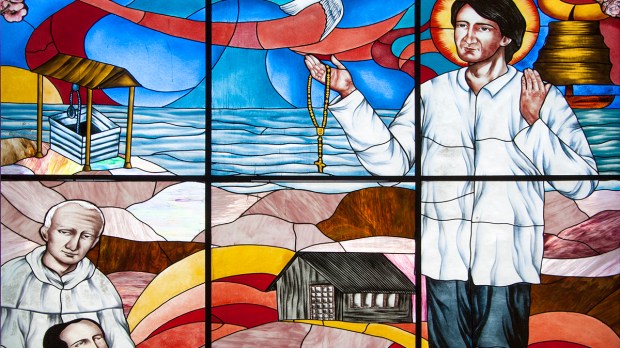In trying to get to know a few of my elder brothers and sisters in the faith — the saints — a good place to look is one of the foremost Catholic countries in the world, the Philippines.
This archipelago consists of more than 7,100 separate islands and is a nation of more than 100 million people. Incredibly, 81 percent of Filipinos are Catholic. (The United States, in comparison, has 69.5 million Catholics. which accounts for a bit over 22 percent of the population). The first Far Eastern saint I learned about was Saint Lorenzo Ruiz, the Protomartyr of the Philippines.
Ferdinand Magellan, on his quest to circumnavigate the world, landed in the Philippines in 1521. He immediately placed the islands under Spanish rule. He named the islands the “Philippines” after Prince Philip (soon to be King Philip) of Spain.
Several Catholic priests had accompanied Magellan and they immediately began spreading the Gospel message. Catholicism spread throughout the islands.
Lorenzo Ruiz was born some 80 years later, around 1600, in Binondo, Manila. His dad was Chinese and his mom was Filipino. Both were devout Catholics and did their best to instill the faith in Lorenzo.
Their son became an altar boy and then a sacristan. He also became a member of the Dominican Confraternity of the Most Holy Rosary. He was trained in the art of calligraphy and became a calligrapher. He got a job and married a woman named Rosario. The couple had three children: two sons and one daughter. They were a happy and ordinary couple. Then fate stepped in and changed their lives.
Spain ruled the Philippines and, for a reason never understood nor proven, Lorenzo was accused of the murder of a Spaniard. The year was 1636 and Lorenzo proclaimed his innocence. But he knew that he faced certain death for a crime he did not commit. He decided to leave his home and seek a safe place to live, praying all the time that he would be cleared of the charges against him.
Lorenzo said goodbye to Rosario and vowed to send her money. Then, in the darkness of the night, he left his home. He managed to connect with two Dominican priests and a leper and was able to get passage on a ship to Japan. The ship left in the middle of June, 1636, and after an arduous journey, arrived in Japan. However, to their shock and dismay, this turned out to be the wrong place for any Catholic Christians.
They had no idea that the rulers of Japan, the Tokugawa Shogunate, hated Catholic Christians. In fact, the Christian population of Japan was actually being annihilated by the Shogunate. (This is more or less the same time as the setting of Shusaku Endo’s Silence.) Within a few days of their arrival, Lorenzo and his companions were arrested. They were told to recant their Catholic faith or face death. They refused.
Read more…“Silence”: Has Scorsese finally found what he was looking for?
Lorenzo and his friends were thrown into prison for two years. Conditions were horrendous and they lived like animals. Back in Manila, Rosario never heard a word and no one knew what had become of Lorenzo. After two years passed, Lorenzo and his companions were transferred to prison in Nagasaki. This is where they would face torture and trial for being Catholic.
The Japanese Shoguns demanded their captives recant their Catholic faith. When they all refused they were hanged upside down over an open pit. Their limbs could be seen but their torsos and heads and shoulders were inside the pit. Their bodies were tied lightly to prolong the agony by allowing their blood to slowly circulate. The captors would make cuts in the prisoner’s heads every few hours to allow blood build up to escape. Man’s inhumanity to man has no rivals.
Three days later all four men were dead. Their bodies were burned and their ashes dumped into the harbor at Nagasaki. Even though the pain had to be unimaginable none of them would deny Jesus Christ. They died martyrs on September 29, 1637, and were beatified on February 18, 1981, by Pope John Paul II.
On October 18, 1987, after two miracles were attributed to Lorenzo’s intercession, he was canonized in Rome by the future saint Pope John Paul II. St. Lorenzo Ruiz is the first Filipino canonized and he is called Protomartyr of the Philippines because he was the first martyr from there. He is the patron saint of altar servers and the Filipino people.
St. Lorenzo Ruiz, please pray for us.

